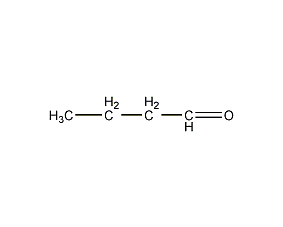
Structural formula
| Business number | 03H0 |
|---|---|
| Molecular formula | C4H8O |
| Molecular weight | 72.11 |
| label |
n-butyraldehyde, casein, Chromaldehyde, Butyric aldehyde, Casein-formaldehyde, Butanal, n-Butanal, n-Butyraldehyde, Plasticizer raw materials, rubber accelerator, pesticide raw materials, aldehyde solvent |
Numbering system
CAS number:123-72-8
MDL number:MFCD00007023
EINECS number:204-646-6
RTECS number:ES2275000
BRN number:506061
PubChem number:24852432
Physical property data
1. Properties: water-white liquid with pungent odor. [1]
2. Melting point (℃): -99[2]
3. Boiling point (℃): 75[3]
4. Relative density (water = 1): 0.80[4]
5. Relative vapor Density (air=1): 2.5[5]
6. Saturated vapor pressure (kPa): 12.20 (20℃)[6]
7. Heat of combustion (kJ/mol): -2479.34[7]
8. Critical temperature (℃): 263.95[8]
9. Critical pressure (MPa): 4.0[9]
10. Octanol/water partition coefficient: 0.88~1.18[10]
11. Flash point (℃): -22 (CC) [11]
12. Ignition Temperature (℃): 218.3[12]
13. Explosion limit (%): 12.5[13]
14 .Lower explosion limit (%): 1.9[14]
15. Solubility: Slightly soluble in water, soluble in most organic solvents such as ethanol and ether. [15]
16. Viscosity (mPa·s, 20ºC): 0.449
17. Flash point (ºC): 230
18. Heat of generation (KJ/kg): 240.45
19. Heat of evaporation (KJ/kg, 74.7ºC): 437.1
20. Specific heat capacity (KJ/(kg·K ), 20ºC): 2.20
21. Thermal conductivity (W/(m·K), 20ºC): 0.1499
22. Relative density (25℃, 4℃): 0.7964
23. Refractive index at room temperature (n25): 1.3766
24. Critical density (g·cm-3 ): 0.280
25. Critical volume (cm3·mol-1): 258
26. Critical compression factor : 0.250
27. Eccentricity factor: 0.345
28. Solubility parameter (J·cm-3)0.5: 18.933
29.van der Waals area (cm2·mol-1): 7.190×109
30. van der Waals volume (cm3·mol-1): 49.270
31. Gas phase standard heat of combustion (enthalpy )(kJ·mol-1): -2511.8
32. Gas phase standard claims heat (enthalpy) (kJ·mol-1): – 204.8
33. Gas phase standard entropy (J·mol-1·K-1): 345.22
34. Gas phase Standard free energy of formation (kJ·mol-1)��� reaction, low consumption, high yield (98%). ![]()
2. The reaction formula of acetaldehyde condensation method is as follows:
3. Butanol oxidative dehydrogenation method uses silver as a catalyst, oxidizes butanol in one step with air, and then condenses the reactants , separation and distillation to obtain finished products. ![]()
4. Preparation method:
![]()
In a fractionation device (receiving bottle Cool it with an ice-water bath), add 41g (0.55mol) of n-butanol (2) and a few grains of zeolite into a reaction flask with a dropping funnel (the bottom extends into the bottom of the bottle), and heat to boiling. Add dropwise a solution composed of 56g (0.188mol) potassium dichromate, 300mL water and 40mL concentrated sulfuric acid, and finish the addition in about 20 minutes. Keep the reaction system boiling and the temperature at the top of the fractionation column does not exceed 85°C. After all the oxidants are added, continue the reaction for 15 minutes and collect the fractions below 90°C. Separate water from the eluate, dry with anhydrous sodium sulfate, fractionate, collect the fractions at 73-76°C to obtain 13g of n-butyraldehyde (1), with a yield of 32%. [28]
Purpose
1. Butyraldehyde is an important intermediate. n-butanol can be produced by hydrogenating n-butyraldehyde; condensation dehydration and then hydrogenation can produce 2-ethylhexanol, and n-butanol and 2-ethylhexanol are the main raw materials of plasticizers. Oxidation of n-butyraldehyde can produce n-butyric acid; condensation with formaldehyde can produce trimethylolpropane, which is a plasticizer for the synthesis of alkyd resin and raw material for air drying oil; condensation with phenol can produce oil-soluble resin; with urea Condensation can produce alcohol-soluble resin; the condensation product with polyvinyl alcohol, butylamine, thiourea, diphenylguanidine or sulfide methyl urethane is the raw material and adhesive for making laminated safety glass, and can be used with various alcohols The condensate is used as celluloid; resin; solvent for rubber and pharmaceutical products; in the pharmaceutical industry, it is used to make “meltol”; “pyrimethamine”; acetate, etc. Plasticizers, synthetic resins, rubber accelerators, pesticides and other important intermediate raw materials.
2. Butyraldehyde is an important chemical raw material. It is also used in the preparation of flavors and spices. This ingredient is contained in various essential oils such as flowers, leaves, fruits, grasses, dairy products, and alcohol in nature. It is usually diluted first before adding the essence, which has a certain effect on coordinating and increasing the elegance of the top fragrance.
3. Used as an intermediate for resins, plastic plasticizers, vulcanization accelerators, pesticides, etc. [27]

 微信扫一扫打赏
微信扫一扫打赏

